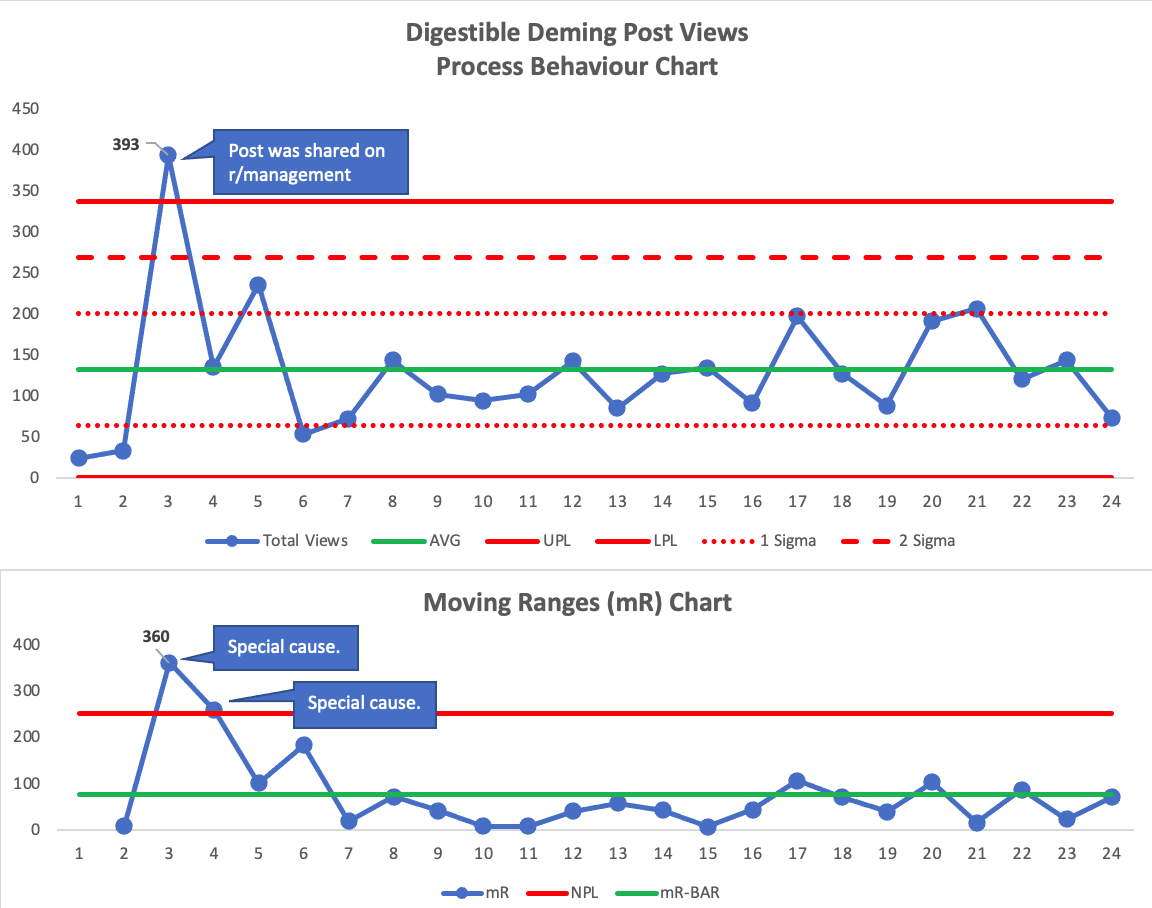Today marks the 25th post of The Digestible Deming, so I thought it worthwhile to pause and take stock of our progress to-date. Looking back at Post #1, my aim was:
[T]o challenge your innate theories or predictions of how the world works and how you comport yourself within the organizations that you manage, work, or volunteer.
with the hope to:
provoke in you a much deeper yearning to learn more about the Deming philosophy and approach to management.
So, how are we doing? A good question that provides us with a “teachable moment” to use our nascent Deming lenses - remember these from the post on Theory of Knowledge?
We’ll first use the lens of variation (for whatever reason, I think this is the green lens in Ben Franklin’s mythical decoder glasses…) as one way we can assess the utility of a newsletter is how much it is read and shared. Naturally, this is a perfect time to construct a Process Behaviour Chart to visualize the variation. I’ve included both the individuals (X) and moving ranges (mR) portions of the chart, along with stratifications to show the estimates for 1 Sigma Unit, 2 Sigma Units, and the Upper Process Limit which is 3 Sigma Units.
What do we observe? One data point stands out on the upper chart, while two stand out on the lower, indicating the potential for special causes. On average, our posts garner 132 views with 18 (75%) falling within one sigma unit of the average, and 23 (96%) within two sigma units of the average. This well-aligns with the Empirical Rule Dr. Donald Wheeler and David S. Chambers describe in their text, Understanding Statistical Process Control, p. 61:
THE EMPIRICAL RULE: Given a homogeneous set of data:
Part One: Roughly 60% to 75% of the data will be located within a distance of one sigma unit on either side of the average.
Part Two: Usually 90% to 98% of data will be located within a distance of two sigma units on either side of the average.
Part Three: Approximately 99% to 100% of the data will be located within a distance of three sigma units on either side of the average.
A sigma unit is, according to Wheeler and Chambers, “a measure of scale for the data” which are used to “express the number of measurement units which correspond to one standard unit of dispersion”. We calculate them from the averages of data points and their deltas (moving ranges) and “scale” them using the formula:
Process Limit (x Sigma) = Average of Data Points + x (Average of Moving Ranges of Data Points) / 1.128
In the case of Post #3, What Must Management Do?, I discovered from looking at the logs that it had been shared on the r/management subreddit, funnelling a lot of casual observers. The two stand-outs on the lower Moving Ranges chart reflect the rapid rise-and-fall of views.
We’re not exactly setting the world on fire, yet, but we are making progress with 64 subscribers receiving the newsletter in their inboxes with an average “open rate” of 50% which sounds good, but still doesn’t tell us how effective we’re being with the knowledge gained. This reminds me of an observation the founder of the Deming Forum in India, Balaji Reddie, made during a talk he gave for the Deming Institute last October while explaining the management of unknown and unknowable figures:
I can measure the attendance of a class, but not their attentiveness - yet, this is something I have to manage as a professor!
Ergo, while we can presume a higher number of views means the lessons are being read more widely, we cannot assume that this translates into understanding, application, or utility. And to be fair, this is a big task as there is variation between each subscriber, their circumstances, and time to process the lessons and learn more about them. Yet, as Balaji notes, I need to manage these elements!
Future Plans
Famed physicist Richard Feynman is alleged to have said that “if you can’t explain something in simple terms, you don’t understand it.” I carry this with me in every Digestible Deming post, along with Dr. Deming’s famous threefold maxim that prefaced his seminars to answer the rhetorical question: Why are we here? To learn, have fun, and make a difference. In this respect, you can expect more posts but on a reduced schedule of twice a week (Mondays and Fridays) and perhaps, if there is interest, a twice-monthly open Zoom call to discuss the topics of the posts and how they can be applied in your context. Let me know what you think in the comments section below.
Announcement
I’d also like to pass along an exciting announcement for me, personally: I’ve been invited by Eric Budd to be a guest presenter for the fall session of Institute for Quality and Innovation Virtual Academy on the topic of Psychology in Deming's System of Profound Knowledge. Classes begin September 13th so there is still time to register and participate in over 40h of high-quality instruction on leading transformations using a Deming lens. The introductory session will be led by none other than David P. Langford, a pioneer in application of the Deming management philosophy in education - this alone is worth the price of admission! My topic will be presented the weeks of December 6-17, hope to see you there!





Hi Chris. I would attend a monthly Zoom call to discuss what we're learning and how we might apply it.